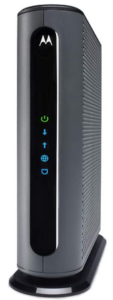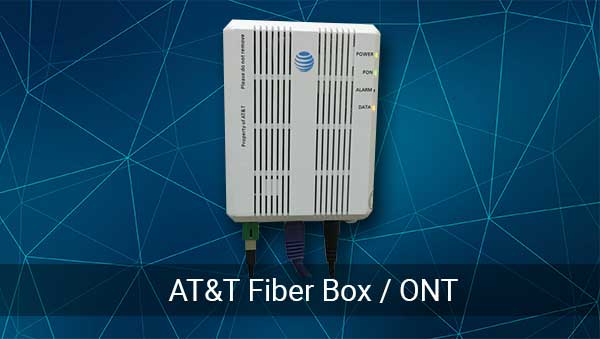We all know the situation when we’re forced by our contract with our ISP (Internet Service Provider) to use their modem. And though we know that our equipment is better and works more efficiently, we have no choice.
This is the reason we get questions like “Can I use my own modem with AT&T Fiber?” quite often. Sadly, the answer largely depends on the type of contract most of our readers signed with their ISP. Nevertheless, we’re going to discuss modems and what you can and can’t do regarding AT&T Fiber.
CONTENTS
What Is a Modem?

First, let’s elaborate a little on what a modem is. “Modem” stands for modulator/demodulator, and it’s a necessary piece of equipment if you want to have internet access in your home. There are variations and there are combinations.
For example, you might have a gateway device that works both as a router and a modem. It performs NAT (Network Address Translation) functions, but it also performs modem functions. Also, depending on the type of provider, you’ll use different modems.
We’re going to discuss the differences between ISPs a little later, but now, let’s focus on what a modem is. Essentially, it’s the device that gives you internet access, and it’s connected to an outlet on your wall with a cable that gives that internet access.
How Does a Modem Work?
As we said, the cables go from the wall to the modem, and these cables transmit data in analog form. This is where the modem comes in. The modem takes analog signals and transforms them into digital signals and vice versa.
The entire ISP infrastructure is based on analog signals traveling in the form of electricity or light. As all remote communication is based on analog signals, so is data transmission. In fact, when you make a call, your voice gets converted into analog signals and turned back into digital ones at the receiver’s end.
Recommended reading:
- Why Is The AT&T Broadband Light Blinking Red And Green, And How To Fix It?
- AT&T Broadband Light Blinking Green: How To Fix It?
- AT&T Broadband Light Red: Meaning and How to Fix It?
It all sounds a bit confusing and exciting, and we know it’s amazing. So, what happens in the modem when you do something on your computer is that it takes the digital data you enter, and it modulates a frequency called “carrier frequency” that it transmits over a telecommunication line.
Difference Between ISPs
Now that you understand what the modem is and how it works, we need to explain the difference between certain ISPs and their services. As there are three different ISP types, there are also three different types of modems.
Cable ISP
First, we have cable modems. These are reserved for ISPs that provide cable internet, and they work with coaxial cables that have an inner conductor, a dielectric, and a conducting shield around them.
The most common type of ISPs is cable because of the price-quality balance. Coaxial cables are not expensive to make or deploy, and their efficiency is great. Anyone that opts for this kind of provider has a good internet connection.
DSL ISP
Second, we have DSL modems. These are used by ISPs that provide the internet through telephone lines. Well, it’s not necessarily the case now, but it was before. Now, they use empty lines.
The signal is transmitted in the form of electricity through a twisted-pair cable. However, the speed you can get from DSL is very slow compared with the other providers. But, it is easily deployable, and it can reach very remote places.
Fiber ISP
Finally, we have fiber modems. These are called ONTs (Optical Network Unit), and instead of having a regular modem, you have a router connected to the ONT using the same cables as for the previous two.
The key difference is that the cables coming to the ONT in your home are very powerful ones because their speed is incomparable to the speed of other cables, but they’re very expensive to deploy.
Fiber optic cables transmit analog signals in the form of light, and that’s why the speed is incomparable. To date, there’s nothing faster than the speed of light, but creating glass and plastic cables is quite expensive.
Modems That Work With Fiber
As we said, the fiber signal comes to your ONT via optic fiber, and these cables don’t go into your outlets from outside the house. The cables from the ONT go to the walls and you can take your pick in terms of coaxial or twisted-pair cables.

Essentially, you can connect any router to the cables coming from your ONT. A modem is going to work, especially if it’s a modem provided by your internet service provider. This doesn’t mean fiber optic modems don’t exist.
There are special modems for fiber optic communication called FOM. However, these are used in special systems where the data need to travel as fast as possible, usually corporate subscribers. Individual subscribers don’t have this kind of opportunity.
Can I Use My Own Modem With AT&T Fiber?

Unfortunately, AT&T doesn’t allow its subscribers to use their modems. You need to use the gateway they provide, and you need to pay for it every month as you’re only renting it as part of the contract.
Now, if instead of “Can I use my own modem with AT&T Fiber?” you asked, “Can I use a different router with AT&T Fiber?”, we’d say yes.
But, you would need to put the gateway into bridge mode so that it doesn’t work as a router and cause conflict in the network once you connect the other router.
Conclusion
There are different types of modems that different types of ISPs use. This is a great thing because we can choose. Of course, different ISPs use different ways of providing internet access, and that’s why some are faster and some are slower.
Of course, if you’re a corporate subscriber you might get a chance to use FOMs because you might need faster data transmission rates.
Finally, the question “Can I use my own modem with AT&T Fiber?” has one answer, and it is “No.”

Hey, I’m Jeremy Clifford. I hold a bachelor’s degree in information systems, and I’m a certified network specialist. I worked for several internet providers in LA, San Francisco, Sacramento, and Seattle over the past 21 years.
I worked as a customer service operator, field technician, network engineer, and network specialist. During my career in networking, I’ve come across numerous modems, gateways, routers, and other networking hardware. I’ve installed network equipment, fixed it, designed and administrated networks, etc.
Networking is my passion, and I’m eager to share everything I know with you. On this website, you can read my modem and router reviews, as well as various how-to guides designed to help you solve your network problems. I want to liberate you from the fear that most users feel when they have to deal with modem and router settings.
My favorite free-time activities are gaming, movie-watching, and cooking. I also enjoy fishing, although I’m not good at it. What I’m good at is annoying David when we are fishing together. Apparently, you’re not supposed to talk or laugh while fishing – it scares the fishes.
